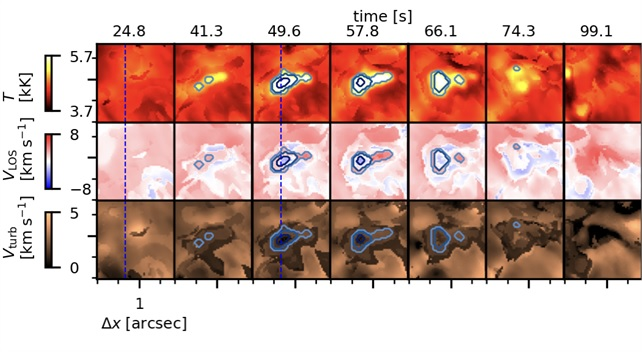A new study has found that bright grains observed in the chromosphere of the Sun are due to upward propagating shocks in the solar plasma, and show higher temperature enhancements than previous estimates. The study can help improve understanding of the mechanism of heating of the chromosphere situated between the bright solar surface and the extremely hot corona.
The chromosphere is a highly active layer within the solar atmosphere and plays a crucial role in transferring energy (specifically non-thermal energy) that heats the corona and fuels the solar wind, which extends outward into the surrounding regions of the solar atmosphere. Although a large portion of this energy is converted into heat and radiation, only a small fraction is actually used to heat the corona and power the solar wind.
There are currently two widely accepted mechanisms regarding how energy is transmitted from the lower layers to the higher regions of the solar atmosphere. The first involves the rearrangement of the magnetic field lines, transitioning from higher to lower potential. The second involves propagation of different types of waves including acoustic waves.
Acoustic shock waves are heating events in the chromosphere that appear as transient brightening in images and are called grains. The amount of energy these acoustic waves carry and how it heats the chromosphere is of fundamental interest in solar and plasma astrophysics.
Led by the astronomers at the Indian Institute of Astrophysics (IIA), an autonomous institute of the Department of Science & Technology (DST), Govt. of India, a team of Solar physicists from India, Norway, and the USA have quantified the temperature enhancements during these acoustic shock events.
Using data that have the highest known imaging, wavelength, and temporal resolution observed so far, the scientists have found that, on average, the temperature rise can be about 1100 K and a maximum of about 4500 K, which is three times higher than estimates from earlier studies. They also found that the atmospheric layers, which show temperature enhancement, move predominantly upwards.
In the study accepted for publication in the journal Astronomy and Astrophysics (A&A), to infer the atmospheric properties during acoustic shocks, the team used high-quality observations of the grains from the Swedish Solar Telescope and a state-of-the-art inversion code called STiC on a supercomputer provided by the IIA. The team has also used machine learning techniques to optimize the process of inversions, thus speeding up the computation significantly.
“The processes by which the energy from the interior of the Sun is transported to the chromosphere and the corona remain a puzzle”, said Harsh Mathur, a Ph.D. student at IIA and the lead author of the paper. “We have been able to determine the temperature enhancements and plasma motion during acoustic shocks. These shocks, caused by sound waves from lower altitudes, can heat the chromosphere”, he added. "These shock waves increase the plasma density of the chromosphere, and as a result, show distinctive brightening (called grains) in the observations that were used to identify such events in this study," explained Nagaraju of IIA, a co-author of the study.
“The temperature enhancements calculated in this study are up to 3-5 times greater than previous estimates,” explained Jayant, Joshi of IIA the principal investigator of the study. “Our results support the interpretation by earlier studies that these are upflowing plasma”, he added.
The team from Bengaluru, India, includes Mr. Harsh Mathur, a Ph.D. student at IIA, Dr. K. Nagaraju from IIA, and Dr. Jayant Joshi from IIA. The team from Norway and the USA comprises Prof. Luc Rouppe van der Voort from the University of Oslo and Dr. Souvik Bose from the Lockheed Martin Solar & Astrophysics Laboratory.
Publication link: https://www.aanda.org/10.1051/0004-6361/202244332
For more information, please get in touch with Harsh Mathur, at harsh[dot]mathur[at]iiap[dot]res[dot]in

Images of temperature, velocity, and turbulence (row-wise) in the chromosphere and how they change with time (columns). The contours indicate the location of the grains (acoustic shocks). At the location of acoustic shocks at t = 49.6, 57.8, and 66.1 s, there is an enhancement in temperature of about 2000 K and upflows of about –3 km/s.






























